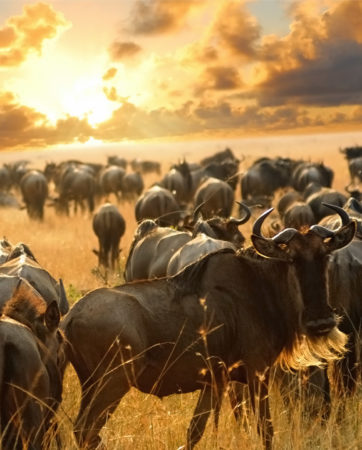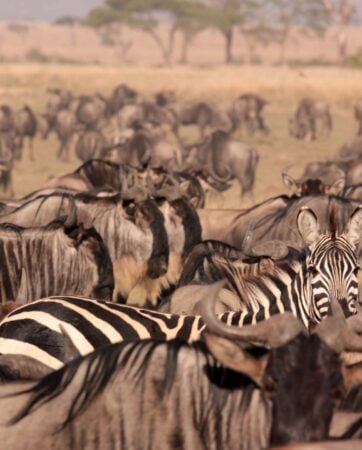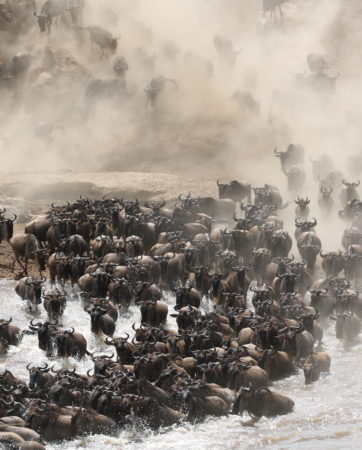Published on: July 25th, 2017
Last updated: February 23rd, 2024
The best time to visit Tanzania is between June and October, the dry season. Clear conditions, little rainfall and less vegetation make this the best time for safaris in Tanzania. You can see the big five in the Serengeti, witness the Great Migration, or try a flying safari in a hot air balloon.
The heavy rains in Tanzania start to ease in June and the high season begins. Ground conditions dry up and vegetation becomes dry and sparse, making wildlife easier to spot, this is the best time of year for safari in Tanzania. Walking safaris in private reserves and conservancies are now possible, experienced climbers look to summit Mount Kilimanjaro and it’s the best time to visit for beach and water activities in Zanzibar.
The wet season in Tanzania starts in November, temperatures climb and dramatic thunderstorms are common. By April and May the conditions are too wet for safaris. Jeeps get stuck in the mud and the wildlife is difficult to spot. As the rains cease in late May the temperatures start to drop and activities become much more comfortable.
Monthly Climate Guide for Tanzania
Although Tanzania’s weather is typically divided into wet and dry seasons – it’s a little more complex than that. Dry months are great for safari experiences and visiting Zanzibar but the shoulder season and wet season offer plenty of highlights too, from excellent bird viewing, wildlife viewing, fewer travellers, dramatic skies and stunning lush green landscapes – perfect for photography.
Here’s a month-by-month climate guide for the safari and beach regions, to help you choose the best time to visit Tanzania for your trip.
Although January falls into the wet season, it can still be a good time to go on safari. It’s summertime, so temperatures are hot, rainfall is lighter and ground conditions are suitable for game drives.
Approximate day time temperature in the Serengeti region 27°C
Safari Events:
Excellent birdwatching all over Tanzania. Calving season for the Wildebeest herds begins in the southern regions for the Serengeti
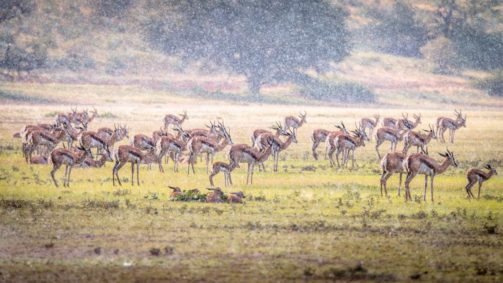
Similar to January; a hot and humid month with the chance of some rain.
Approximate day time temperature in the Serengeti region 27°C
Safari Events:
Another great birdwatching month in the Lake Manyara area.
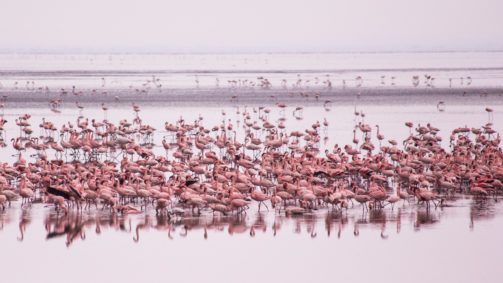
A hot humid month, just before the heavy rains begin.
Approximate day time temperature in the Serengeti region 28°C
Safari Events:
Another green season month that can be great for birdwatching experiences.
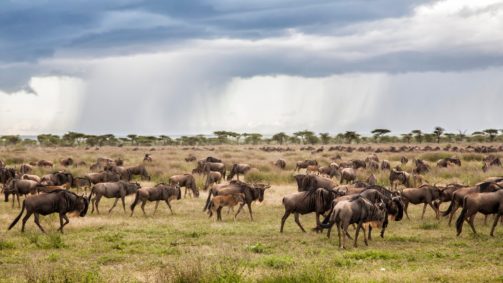
The very heavy rains start in earnest in April.
Approximate day time temperature in the Serengeti region 27°C
Safari Events:
It’s not a good time to go on safari as the wildlife is hard to spot and safari jeeps often get stuck in the mud as they try to move around.
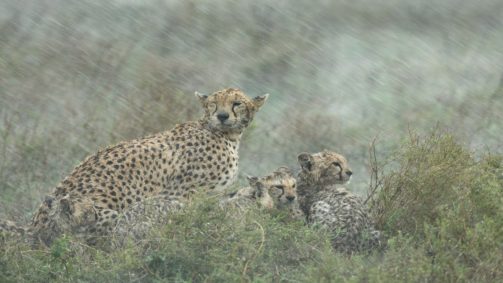
Similar to April, a hot and rainy month. Towards the end of the month the rains can start to dry up but conditions underfoot are still very wet.
Approximate day time temperature in the Serengeti region 25°C
Safari Events:
It's best to avoid safari the ground begins dry, at the very end of the month.
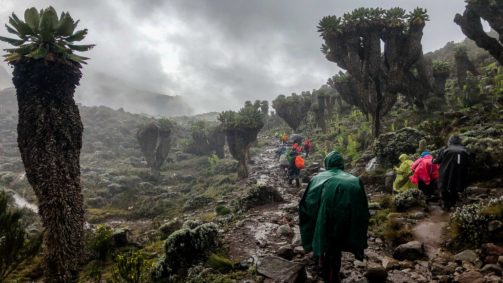
The rains are light in June, with minimal showers and clear sunny days. In Zanzibar, from June until October temperatures are balmy with clear skies and minimal rainfall.
Approximate day time temperature in the Serengeti region 25°C
Safari Events:
This is a very pretty time of year with lush green landscapes attracting many migratory birds. In the south of the Serengeti it's possible to find huge herds of wildebeest migrating northwards, attracting predators.
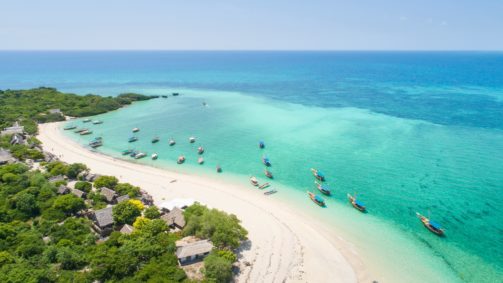
By now the rains have typically completely subsided, temperatures are cool, days are clear and vegetation is drying up completely.
Approximate day time temperature in the Serengeti region 25°C
Safari Events:
July is a great month to go on safari. Visitor numbers increase and areas such as the Ngorongoro crater get busy. The wildebeest start their dramatic river crossings in the northern Serengeti now.
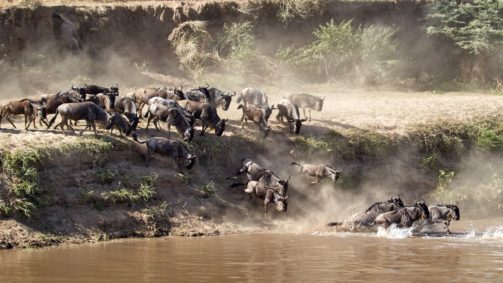
Similar to July, another beautiful month in Tanzania. Conditions are dry and high densities of wildlife must congregate together at the remaining water sources.
Approximate day time temperature in the Serengeti region 25°C
Safari Events:
August is a great month for safari with dramatic wildebeest river crossings in the northern Serengeti.
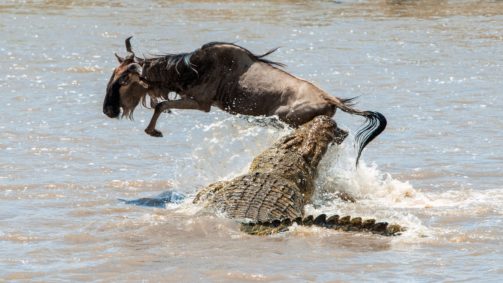
Temperatures are getting hotter now and high densities of wildlife at watering holes result in fantastic wildlife viewing.
Approximate day time temperature in the Serengeti region 27°C
Safari Events:
Another good month to witness dramatic river crossings as thousands of wildebeest and zebra (and predators) are now on both sides of the Mara River.
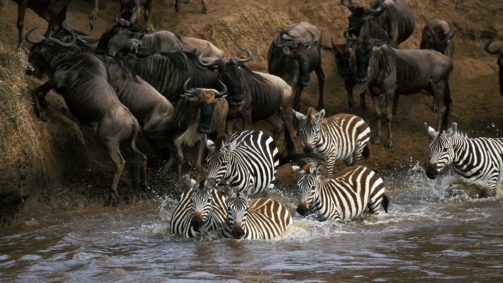
The mercury is rising and conditions are very hot and dry. Safari in Tanzania is still good around the remaining water sources as the wildlife waits for the refreshing rains to come.
Approximate day time temperature in the Serengeti region 27°C
Safari Events:
The Great Wildebeest Migration has now moved into Kenya in the search for fresh pastures.
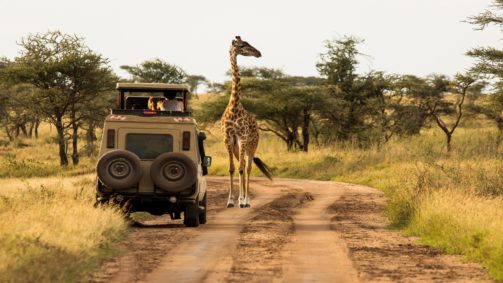
The wet season begins and the rains start to fall, temperatures drop slightly. Showers are usually isolated, taking place in the afternoon or overnight and there can be spectacular thunderstorms.
Approximate day time temperature in the Serengeti region 26°C
Safari Events:
Despite being in the green season, November can be a good safari month. The exciting river crossings start again in the north as the wildebeest herds make their way south, ready to start the calving season.
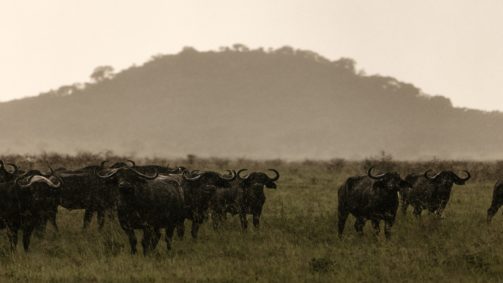
A similar month to November with some isolated showers, hot temperatures
Approximate day time temperature in the Serengeti region 27°C
Safari Events:
There’s potential for excellent game viewing during December, a green season month. The wildebeest herds are still moving south and migratory birds are starting to arrive for some beautiful bird watching experiences.
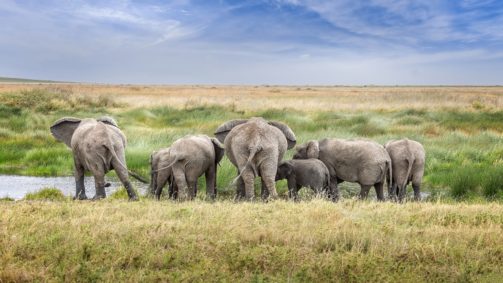
Top Things To Do in Tanzania
There are lots of different things to do in Tanzania, it’s not just about finding the big five or witnessing the epic great wildebeest migration, although these are good reasons to visit.

Go on Safari in Tanzania
The best time to go on safari in Tanzania is during the dry season between June and October. July and August are the busiest months while June, September and October offer great safari and fewer crowds in the more remote areas. Dry conditions are perfect for wildlife viewing as vegetation is sparse and high densities of wild animals congregate at rivers and water holes.
At Wilderness Usawa Camp, Mwiba Private Reserve, Singita Grumeti and Chem Chem you can enjoy walking safaris and bush walks during the dry season. Between July and October less vegetation makes it safe to set out on foot with expert guides. Walking safaris, combined with hot air balloons and traditional game drives offer a subversive and rewarding safari experience.

Go Birdwatching
The best time to go to Tanzania for birdwatching is between November and May, the green (wet) season. Thousands of migratory birds flock to Tanzania during the green season and you can also spot impressive numbers of pink flamingos at Lake Manyara. To see birds with their impressive breeding plumage the best months to visit are November and December and late March to May.

Explore beaches
July to September is the best time to visit the palm fringed islands of the Zanzibar archipelago . During this period, visitors can enjoy cloudless skies and beautiful beach days. At this time there is little to no rainfall. Zanzibar's white sand beaches and turquoise waters can still be explored during October to June, with temperatures typically staying between 28°C (82.4°F) and 34°C (93.2°F) all year round.
We recommend sailing on Dhow boats, snorkelling in the crystal clear waters, visiting a spice farm and of course relaxing on the beaches and enjoying spectacular sunsets.

Search for Chimps
Chimp trekking through the Mahale Mountains of Tanzania is a once-in-a-lifetime experience, so you’ll want the best conditions. The dry season of July to October makes climbing easier, meaning you can move deeper into the dense forest, closer to the chimps. These months also see fruit blooming on the lower slopes and bushes, attracting the chimps closer to ground level for better sightings.

Find large herds of elephants
The best place to see large herds of elephants in Tanzania is Tarangire National Park, where you'll find large numbers gathering during September and October. These months are very dry and hot with temperatures reaching 29°C (84.2°F) The Tarangire River is a magnet for hot elephants, in great need of water, who come here to cool off in this vital year round water source.

Hot Air Balloon Flights
Soaring over the Serengeti, getting a privileged birds-eye glimpse into the natural world below is a must-do experience. If you want to gaze down upon the massive migration, including river crossings, you’ll need to be in the north of the Serengeti and you should travel during July to September. The dry season offers the best clear and calm conditions. In the south of the Serengeti there are some options to balloon safari year round.
The Best Time to Visit Tanzania for The Great Wildebeest Migration
The Great Migration is a continuous, annual journey made by wildebeest and zebras through Tanzania and Kenya. However, some areas and months will experience more dramatic wildlife spectacles. July to September are considered the peak months to visit the northern Serengeti to see the migration and catch the iconic Mara river crossing. With the help of our travel designers, we have also put together a full guide to the Great Wildebeest Migration here.

The green season, between late January to early February, is the best time to visit southern Serengeti to witness the wildebeest birthing season. Approximately 8,000 calves are born each day, attracting high concentrations of lions, cheetahs, leopards and raptors on the hunt for young wildebeest. The surviving young are tended by their mothers into March and April as they grow strong enough to migrate north.

The wildebeest migration continues its journey north, towards Kenya during May and June. This is one of the best times to see the large concentrations of wildlife in the exclusive Grumeti Private Reserve, as the herds cross the Grumeti River.

The best time to visit Tanzania to see the river crossings of the Great Migration is between July and October, the dry season. The herds start to pick up the pace in search of greener vegetation and cross the Mara River to make it into Kenya. The Mara River is characterised with steep banks and good water levels. Observe dramatic crashes as thousands of wildebeest leap into the water.

During the end of October and start of November the migration is mainly now in Kenya. As November progresses the herds move south, back to north-eastern Tanzania and start the cycle of migration again. In December, the lush vegetation of the Serengeti draws herds of wildebeest, zebras and other animals further south where the calving season begins again.
The Best Time to Climb Mount Kilimanjaro
July to October is the best time to visit Tanzania to climb Mount Kilimanjaro. Little rainfall means dry conditions, making the climb more comfortable. However, temperatures can get below freezing and snow on the high passes is common. January to March are also good months to climb, rainfall is moderate and temperatures are a little warmer.
It’s best to avoid April, May and November as these are the wettest months with the poorest climbing conditions.

Beginner Climbers
January to March are great months for beginners to climb Mount Kilimanjaro. The weather conditions are stable and temperatures are warmer, the very cold months later in the year can be challenging for beginners.
For beginners it’s a good idea to choose a route you can climb at a slower pace. More time means you can acclimatise to the altitude and enjoy and explore your surroundings. The northern and western routes of Shira and Lemosho can take place over 8 nights and 9 days, a longer time period and often less crowded

Experienced Climbers
The best time for experienced climbers to summit Mount Kilimanjaro is between March and July. Due to colder and snowy conditions fewer travellers tackle the mountain so you can avoid the crowds for an authentic experience in nature.
Experienced climbers can opt for the popular Machame ‘whisky’ route. Approaching from the southwest you’ll pass through a variation of landscapes and reach altitude quickly. The faster pace means you can complete the climb in 6 days and 5 nights. This gives you more time to enjoy Tanzania's other highlights such as safari in the Serengeti or enjoying a well-earned rest on the beaches of Zanzibar.
Our Team's Favourite Trips to Tanzania
Get in touch to start building your Tanzanian adventure
Where to Stay in Tanzania
"Our trip to Tanzania was truly the trip of a lifetime."
“We have been to many places all over the globe and this trip is by far our most memorable. From the very beginning Samantha Kelly made the whole process enjoyable. She mapped out a great itinerary that was incredible. The lodging, food, guides and field trips exceeded our expectations. We would recommend using Jacada Travel to anyone that wants to visit Africa.”
John, 5 Stars
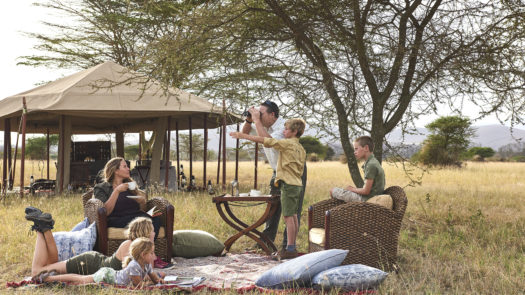
Trip Inspiration
Whatever you want from your trip to Tanzania, our team of expert travel designers are ready to help.

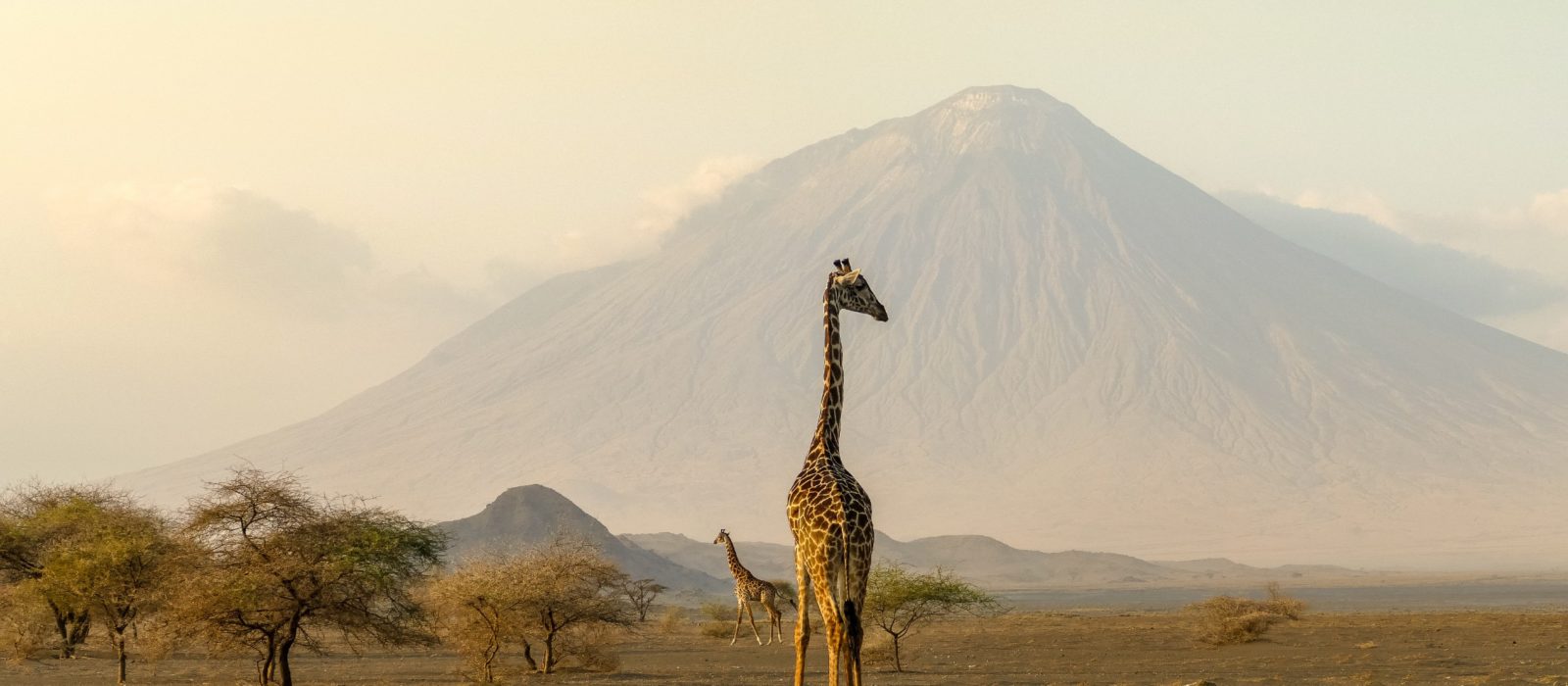

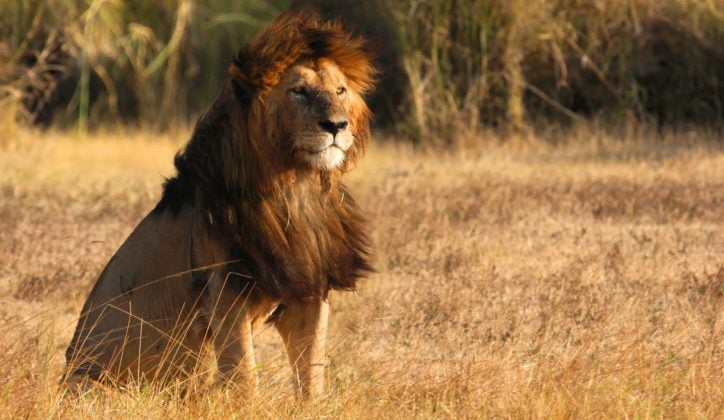
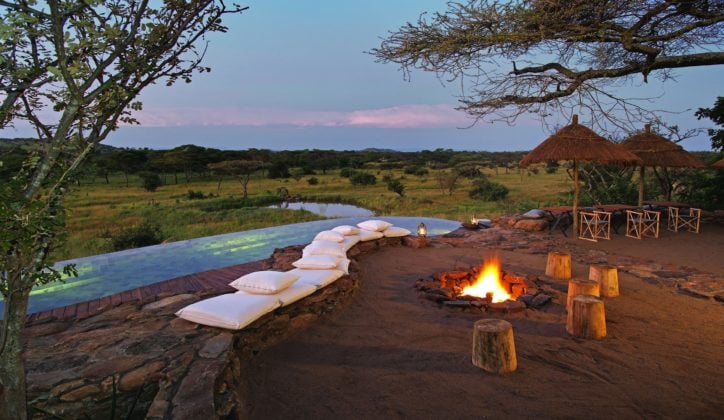
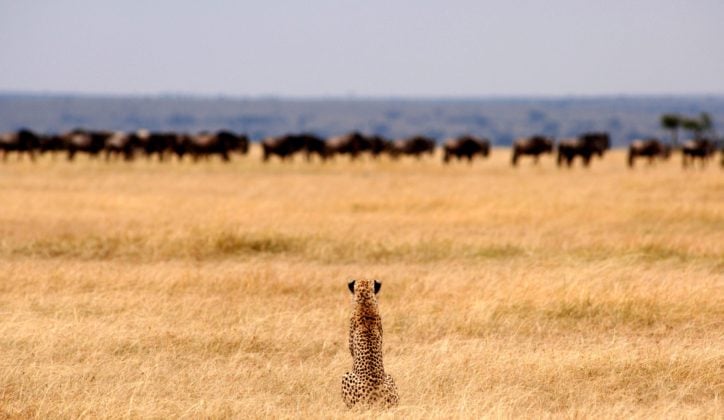
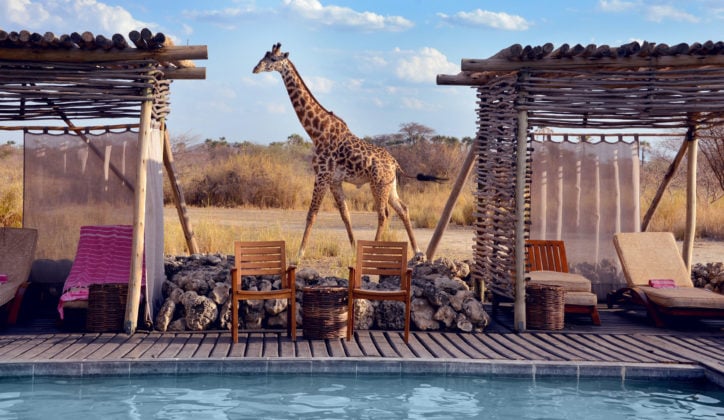


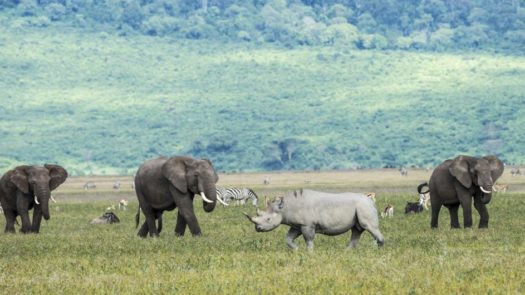



RS_2-132x76-cc.jpg)







_0-132x76-cc.jpg)

